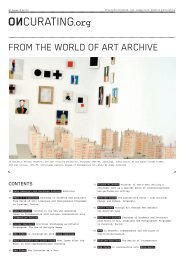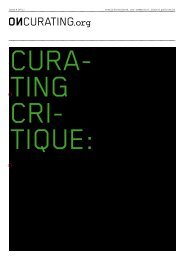You also want an ePaper? Increase the reach of your titles
YUMPU automatically turns print PDFs into web optimized ePapers that Google loves.
020 Issue # 11/11 : PublIc Issues<br />
85 New Wave (1980 — 1990) 7<br />
Reality diverges slightly from the accounts of the former<br />
curators and organizers. The china/Avant-Garde exhibition<br />
in the National Art Museum included over 200 Chinese<br />
artists from different groups, like the Northern Art Group<br />
founded in 1985 by Wang Guangyi, Shu Qun, Ren Jian and Liu<br />
Yan among others, or the southern Artists salon, or indeed<br />
Xiamen Dada. Other participants were artists or groups<br />
from the organizers' social circles.<br />
The 85 New Wave can be seen <strong>as</strong> an extensive m<strong>as</strong>s movement,<br />
initiated through the people, intellectuals, and students.<br />
It no longer bore any kind of relation to the Cultural<br />
Revolution. As more information on modern and contemporary<br />
art w<strong>as</strong> obtained from abroad, cultural ideologies and<br />
activities experienced an unprecedented development. The 85<br />
New Wave w<strong>as</strong> a potent and democratic movement, a huge cul-<br />
tural trend that had sprung up in all provinces and cities.<br />
It concluded with Tang Song and Xiao Lu's perfor-mance<br />
Two Gunshots Fired at the Installation: A Dialogue, which<br />
marked the end of the china/Avant-Garde exhibition in 1989<br />
(Berghuis, 2006). Its effect w<strong>as</strong> not only the termination<br />
of communication between the people and the government, it<br />
can also be seen <strong>as</strong> a metaphor for the subsequent student<br />
movements.<br />
At the exhibition entitled '85 New Wave: The Birth of<br />
Chinese Contemporary Art', curated by Fei Dawei at the end<br />
of 2007, the movement w<strong>as</strong> described <strong>as</strong> follows:<br />
"The 85 New Wave w<strong>as</strong> one of the most important<br />
art movements in China's 20th century art history,<br />
it created a new era, defeated the instrumen-<br />
talism and monism of art and made the first step<br />
for China's contemporary art. Many groundbreaking<br />
works were also created during this period [...]."<br />
The exhibition took place at the UCCA (Ullens Center for<br />
Contemporary Art). Eighteen years have p<strong>as</strong>sed since its<br />
exhibition at the National Art Museum in 1989. However, if<br />
we compare the locations, the former represents the sacred<br />
halls of China's institutionalized art, where<strong>as</strong> the latter<br />
is a private gallery in Beijing's 798 art district opened<br />
by Guy Ullens and his wife.<br />
Shanghai Biennale and Guangzhou Triennale (1996 — 2010)<br />
The first Shanghai Biennale took place in 1996. Until the<br />
second, it tried to cut into Chinese contemporary art, but<br />
the effect w<strong>as</strong> only very minimal. Neither exhibition is<br />
mentioned in official reports. Most people learned about<br />
the Biennale in 2000. Because of its international team of<br />
curators and artists, its record-breaking expansive exhi-<br />
bition space and media coverage, contemporary art reached<br />
a level of extreme publicity. This directly influenced<br />
the sudden incre<strong>as</strong>e of biennales across the country: one<br />
after another Chengdu, Guizhou, Nanjing, and Guangzhou all<br />
held biennales or triennales. The Guangzhou Triennale,<br />
which started in 2002, is especially noteworthy <strong>as</strong> it made<br />
the greatest contribution to improving the image of ex-<br />
perimental art.<br />
The absence of Western curators from the 2010 Shanghai<br />
Biennale aligns to a certain extent with predicated future<br />
trends. But the transfer of Wang Huangsheng from the<br />
Guangdong Museum of Art to the CAFA Art Museum (Museum of<br />
China Central Academy of Fine Arts) might spell the end of<br />
the Guangzhou Triennale. At the same time, however, bien-<br />
nales and triennales across the country are continuously<br />
being founded and disappearing again, so no clear tendency<br />
is visible. Moreover, these developments directly affect<br />
the government's understanding of contemporary art.<br />
7<br />
On the 85 New<br />
Wave, see http://<br />
www.artspeakchina.<br />
org/mediawiki/<br />
index.php. The New<br />
Wave Movement of<br />
the mid-1980s w<strong>as</strong><br />
a continuation<br />
of the p<strong>as</strong>t era.<br />
It w<strong>as</strong> b<strong>as</strong>ed<br />
almost entirely on<br />
the theories,<br />
conceptual ide<strong>as</strong>,<br />
and visions of<br />
Western modernism.<br />
It consisted of<br />
regional, folklo-<br />
ristic art<br />
groupings that<br />
mobilized a<br />
national modernist<br />
art movement on an<br />
unprecedented<br />
scale. Some of the<br />
noteworthy groups<br />
with a certain<br />
kind of continuity,<br />
size, and<br />
theoretical<br />
approach were the<br />
Northern Art<br />
Group, the Jiangsu<br />
Neo-Primitivism<br />
Group, the Red<br />
Brigade (Nanjing),<br />
the Pond Society<br />
(Hangzhou), Xiamen<br />
Dada, Tribe·Tribe<br />
(Wuhan), and the<br />
Southwest Art<br />
Research Group.<br />
8<br />
See the Beijing<br />
Art Zone map at<br />
http://www.ionly.<br />
com.cn/nbo/news<br />
info3/200708291/<br />
1635091.html.<br />
Yuanmingyuan, Songzhuang, E<strong>as</strong>t Village, 798 Art Zone,<br />
Caochangdi, and other art districts (1984 — 2010)<br />
Yuanmingyuan artist village came into being in 1984, pro-<br />
viding a home to several hundred art pioneers. Especially<br />
after 1989, this area developed into a meeting place for<br />
artists, poets, writers, stage and documentary directors,<br />
until the forced eviction of the whole area in 1995. After-<br />
wards most of the artists scattered around Beijing and<br />
moved to places like Huajiadi, Songzhuang, Mudanyuan, Tong-<br />
xian, just to name a few.<br />
Around 1993, the E<strong>as</strong>t Village, which w<strong>as</strong> located in today's<br />
E<strong>as</strong>tern part of the Third Ring Road, turned into an im-<br />
portant location for performance art (see Annex). Ma Liuming<br />
and Zhang Huan's live performance Dialogue with Gilbert<br />
and George in 1993 foreboded for one thing Chinese contemporary<br />
art's future relation to the world; for another,<br />
it showed in a certain sense a continuity with the china/<br />
Avant-Garde of 1989, <strong>as</strong> both took place in the National<br />
Art Museum, that is, the sacred halls of Chinese institutionalized<br />
art. Unfortunately, the E<strong>as</strong>t Village only ex-<br />
isted for two years before it w<strong>as</strong> banned by the government.<br />
As for Songzhuang, due to its remote location, which is an<br />
estimated 30 minute drive from the district town of Tong-<br />
zhou, the two thousand resident artists have managed to<br />
create a stable working and living environment that still<br />
exists today.<br />
798 w<strong>as</strong> discovered in 2002, whereupon artists gradually<br />
started to move there. In 2003, it w<strong>as</strong> almost demolished<br />
due to reconstruction plans of the local administration.<br />
From 2003 to 2006, while continuously accommodating<br />
artists and galleries, the question of the area's future<br />
demolition and renovation were still on the table. In<br />
2008, 798 became a government promoted trendy art district,<br />
which eventually turned into an important location for the<br />
official creative industry. Only thereafter w<strong>as</strong> its ex-<br />
istence secured.<br />
With the opening of UCCA in 2007, people took notice of<br />
the arrival of foreign funds, while at the same time<br />
Chinese contemporary art reached its second peak upon<br />
entering the auction markets. Through its location next to<br />
Huajiadi art district and the CAFA, 798 naturally expanded<br />
in a northe<strong>as</strong>tern direction, <strong>as</strong>similating the villages and<br />
creating today's Caochangdi and Huantie (circular railway)<br />
art districts and also a bit further away, the Feijiacun<br />
Artist Village, <strong>as</strong> well <strong>as</strong> the 1 Art B<strong>as</strong>e and Beijing 318<br />
Art Garden among others. 8<br />
All these art districts, studios, galleries, and private<br />
museums provided enough exhibition space, technical and


![Download as PDF [10.6 MB]](https://img.yumpu.com/4266533/20/500x640/download-as-pdf-106-mb.jpg)

